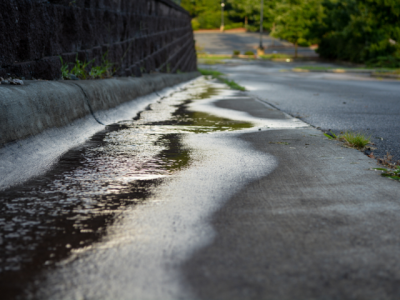
The Vermont Agency of Transportation is accepting grant applications for three grant programs:
- the Better Roads Grant Program (Better Roads),
- the Transportation Alternatives Program (TAP), and
- the Municipal Highway and Stormwater Mitigation Program (MHSMP).
What do these programs fund?
Better Roads funds smaller municipal road projects that improve water quality and result in maintenance cost savings.
TAP funds projects defined as transportation alternatives, including on- and off-road pedestrian and bicycle facilities, infrastructure projects for improving non-driver access to public transportation and enhancing mobility, community improvement activities, and environmental mitigation, trails that serve a transportation purpose, and safe routes to school projects. Salt and sand sheds that can demonstrate a link to water quality improvement are eligible for TAP funding. All projects must demonstrate a strong transportation link.
MHSMP funds larger environmental mitigation projects, including planning studies, salt and sand sheds where construction would have a water quality benefit, bank stabilization, culvert replacement/resizing, detention ponds and infiltration basins, check dams, swirl separators, permeable pavers, gravel wetlands, and other stormwater projects related to the transportation system.
What kinds of funding are available?
Better Roads funds road erosion inventories (Category A) and smaller construction projects (Categories B, C, and D).
- Category A applications ask municipalities to apply for a set amount based on a predetermined VTrans schedule.
- Category B projects must correct a road related erosion problem and/or stormwater mitigation/retrofit for both gravel and paved roads. The maximum grant amount is $20,000.
- Category C projects must correct a streambank, lakeshore, or slope related program. The maximum grant amount is $40,000.
- Category D projects are structure and culvert installations or replacement for culverts of 36 inches or larger. Category D is intended to fund one single culvert or structure that is not under the Municipal Roads General Permit jurisdiction. The maximum grant amount is $60,000.
TAP funds both scoping/feasibility studies and construction projects. Approximately 50% of TAP grant program funds are reserved for pollution mitigation projects relating to stormwater and highways, including eligible salt and sand shed projects. Scoping/feasibility studies typically are awarded $40,000 to $70,000 while construction projects can request up to $600,000. Salt and sand sheds can apply for up to $500,000.
MHSMP funds both scoping/feasibility studies and larger construction projects. There is not a program cap on the amount of funding an applicant can request for a project.
How does my community apply?
A Letter of Intent (LOI) for Better Roads Category A projects (road erosion inventories) are a fillable form submitted via email. LOIs will be accepted on a first come, first served basis until 12/31/24 or until funds are exhausted.
Applications for Better Roads Category B, C, and D projects (construction) are a PDF form (non-fillable) submitted via email. Applications are due 12/27/24.
TAP and MHSMP use a web-based Survey Monkey application. You use the same application to apply to both programs. VTrans decides which program is the best fit to your project. You can submit multiple applications. Applications are due by 12/31/24.
What will make our application competitive?
Better Roads: Projects must protect or enhance water quality. Construction projects that are in full compliance with the Municipal Roads General Permit are most competitive.
For TAP and MHSMP,
- Projects must demonstrate a strong transportation link.
- Eligibility for salt sheds is considered on a case-by-case basis based on proximity of the existing storage location to a major water body (generally within 50 ft.).
- Projects that have a scoping/feasibility study completed are more competitive.
- If a project is not completed (study not finished, construction project doesn't advance past design), pay back of all federal funds is required. It can be helpful to budget for robust public engagement (more than the required meetings) for both scoping and construction projects.
- Project sponsors are required to have a qualified local project manager. Remember to budget for this cost.
- Be realistic about timing. Design and construction projects funded through these programs typically will take 3-4 years to complete.
Additionally:
TAP: Describing your trail or path as "recreation" will make it less competitive; the focus of this grant is transportation (traveling to and from destinations). If you are requesting additional funding, your project must have a current NEPA clearance and Right of Way clearance to be eligible.
MHSMP: Projects must demonstration a clear water quality benefit. Projects that treat a higher portion of highway runoff are more likely to be awarded. Submit pictures and a map(s) to help describe and demonstrate the problem.
How can my community learn more?
Better Roads:
- For project and program technical information questions, contact Alan May at 802-828-4585, Dan Judkins at 802-595-6184, or email Betterroads@vermont.gov.
- For funding or general program questions, contact Ross Gouin at 802-595-2381 or ross.gouin@vermont.gov.
TAP: Contact Scott Robertson, Transportation Alternatives Program Manager, at 802-793-2395 or scott.robertson@vermont.gov.
MHSMP: Contact Ross Gouin, Municipal Highway Stormwater Mitigation Program Manager, at 802-595-2381 or ross.gouin@vermont.gov.
Where can my community find help with grant writing or management?
VLCT published a resource, Increasing Municipal Capacity for Grants, that offers ideas for assistance with grants. Many of the capacity builders also provide project management services. Hiring experienced project management assistance can increase the speed of project development and help avoid cost, permitting, and other development surprises.